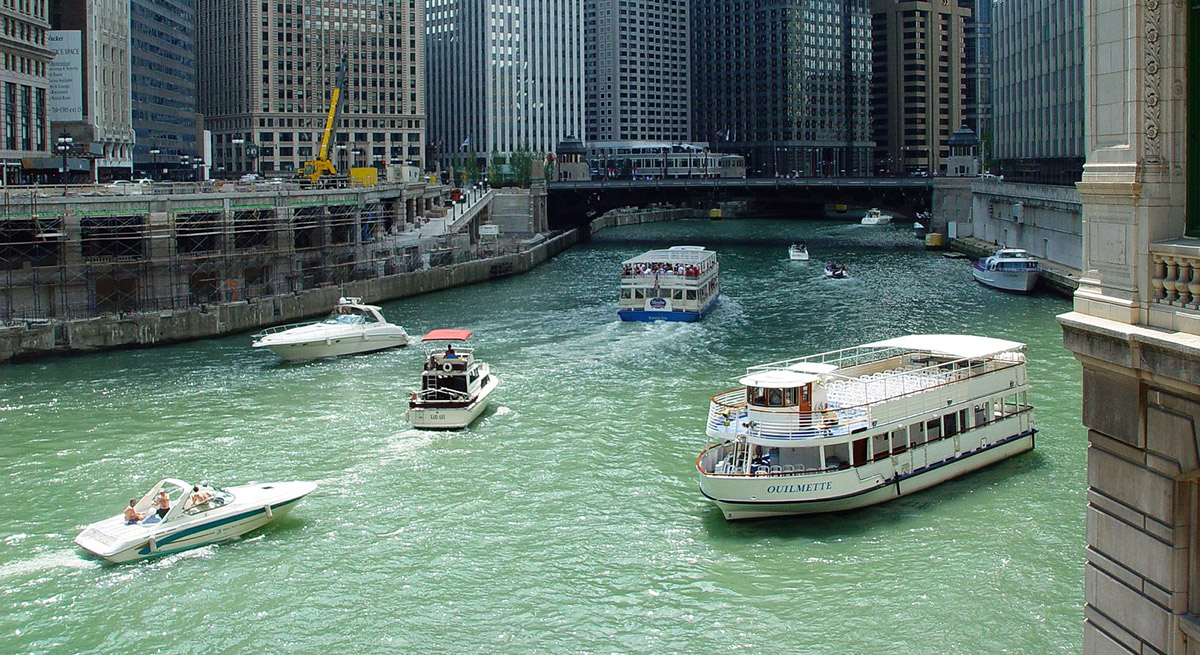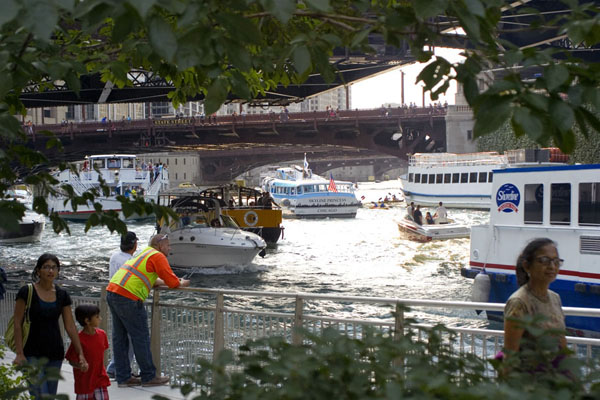A push for rules and order as recreation booms on Chicago's rivers

Credit: Wendella Sightseeing
Could you imagine rush hour in Chicago if there were no rules of the road? The mass chaos, confusion and danger that would ensue is limited only to one's imagination.
Cars, buses, trucks, bikes and pedestrians would all converge onto a 66-foot-wide pathway to peril. No one would get anywhere, business productivity would be halted, social plans would be spoiled. A street without rules and rights-of-way, signals and signage, defined vehicle and bike lanes and crosswalks would be a disaster—and the same is true of a river.
As Chicago's rivers grow more crowded every year—a good "problem" to have—it's increasingly important to shore up protocols, education and enforcement of the rules governing everyone who uses the rivers. And those users are many: Industrial barges and tugboats are busy carrying much-needed cargo, such as cement and concrete for building our city and salt for our roadways. Commercial and charter tour boats and water taxis are ferrying people around the city via our rivers, with a best-guess estimate of at least 65,000 trips in 2014 on U.S. Coast Guard-licensed and inspected commercial passenger vessels. Then there are the multitude of pleasure cruisers, sail boats, rental boats, jet skis, canoes, kayaks and paddle boarders. Add them all up, and there is a veritable smorgasbord of water crafts competing for room in our narrow riverway channels.
A towboat with a loaded barge may need several hundred feet to stop.
In fact, there are more than a dozen rental craft operators on the rivers today. This includes paddle boards, kayaks and canoes, pontoon boats and electric boat rentals. This is great; more Chicagoans are taking advantage of our more than 100 miles of awesome rivers. At the same time, a growing number of serious incidents have been reported on our rivers, some due to inexperienced recreational users causing accidents and near-misses. Unlike licensed mariners, casual users—who typically need only a credit card and driver's license to rent a pontoon or electric boat in Chicago—may not know or understand nautical rights-of-way and maritime rules. Indeed, no maritime training or license is required to operate a recreational vessel in Illinois.
And the rules of the river are not the same as the rules of the road. For example, the Law of Gross Tonnage states that, "the larger vessel has the right-of-way on the water. This is because they are less maneuverable, have trouble seeing smaller boats and can do more damage when in a collision. Kayaks and canoes should therefore yield the right of way and stay out of the way of larger boats."
This rule runs contrary to how we think about rights-of-way on our streets, where pedestrians trump everyone—and there is good reason for this: Vessels on the water have a more difficult time stopping quickly. Depending on its speed and cargo, a towboat with a loaded barge may need several hundred feet to stop.

The U.S. Coast Guard Navigation Rules and Regulations Handbook outlines the established rules of maritime navigation. Mariners who operate the industrial and commercial vessels in our rivers have to be licensed and abide by these rules. Yet there is no requirement that water craft rental companies ensure their customers are versed in the rules of the river. With the proliferation of recreational water craft rental users who are often uneducated about marine safety, the risk of a casualty or serious incident on our rivers will rise.
Another safety challenge is that there is minimal law enforcement on the rivers on a daily basis. While several local, state and federal agencies have some purview over maritime safety—including the Chicago Police Department, Chicago Fire Department, U.S. Coast Guard, Ill. Dept. of Natural Resources and Metropolitan Water Reclamation District of Greater Chicago—these agencies all have varying authorities and responsibilities with regard to matters such as marine incident response, monitoring alcohol consumption and general vessel operation and/or licensing regulations. Many of these agencies also face budget and staffing constraints to meet all of their river and non-river responsibilities.
In an effort to develop clearer communication and cooperation among regulating authorities and all the different users of our rivers, the Chicago Harbor Safety Committee was formed in the summer of 2013. This broad-based stakeholder forum identifies, plans, communicates and implements sound measures to "ensure safe, secure, efficient and balanced management, operation and development of Chicago area waterways." This committee of more than 40 government agencies, private companies and operators and civic and environmental groups meets quarterly to discuss usage trends and issues emerging on our waterways. The committee has been successful in collaborating with the Chicago Dept. of Transportation and its contractors on Chicago's new Riverwalk downtown; communicating and distributing vital information to river users about navigation rules as well as up-to-date notices about infrastructure issues, such as bridge closures and lift schedules; and installing new signage along the riverways to assist users in understanding some basic rules of the river.

Credit: Steve Dahlman
These steps are a good start, but there's still plenty of room for improvement. Michael Börgstrom, president of Wendella Sightseeing Company and the Chicago Harbor Safety Committee, says, "recent collaborative efforts between the multiple agencies involved in maritime activities is encouraging, but a great deal more needs to be done to ensure everyone is able to safely enjoy our rivers and riverfront."
Great Rivers Chicago is bringing multiple agencies and stakeholders together to develop a vision and action agenda for Chicago's rivers and riverfronts, including riverway safety. The river belongs to everybody, from the biggest barge to the smallest kayak. By establishing some universal rules and standard practices, we can make sure everyone is able to navigate and enjoy our rivers safely.
« Back to stories